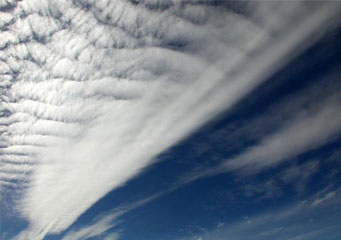
Above: Stratus
Stratus
Stratus clouds belong to the stratiform category of tropospheric clouds. The category is based on the physical structure of the clouds and its corresponding transformation process. Stratus or strato is the Latin term for sheet so clouds which belong to the stratiform category like stratus clouds are sheet-like in structure. Stratus clouds are one of the ten genus types of clouds. The other nine are cirrus, cirrocumulus, cirrostratus, altocumulus, altostratus, stratocumulus, nimbostratus, cumulus and cumulonimbus.
What are stratus clouds?
Stratus clouds are low-lying clouds with a uniform base and are horizontally layered. They usually come in dark gray or almost white color and are usually hazy-looking much like smoke. When they are earth-bound, they are commonly called fog or mist. These clouds are flat, featureless and since they form in horizontal layers, they block out the sun during a cloudy day. Although these clouds do not produce much precipitation, they sometimes do so in small quantities in the form of drizzle, snow grains or small ice crystals.
What height is stratus clouds formed?
As earlier noted, stratus clouds belong to one of the two low-lying cloud types, the other one being the genus stratocumulus clouds. The base of stratus clouds appears to be just above the ground and reaches up to only approximately 6,500 feet or 2000 meters in temperate latitudes. As such these clouds are mostly composed of water droplets but when the temperature becomes cold enough, they could also contain snow and ice particles. The clouds are not particularly concentrated in any area because they occur worldwide but they can be commonly seen in mountainous and coastal areas.
Types of stratus clouds
- Stratus fractus
- Stratus translucidus
- Stratus praecipitatio
- Stratus undulatus
- Stratus nebulosus
- Stratus opacus
Classification of stratus clouds
The two main species of stratus clouds, namely stratus fractus and stratus nebulosus, are better known. Unlike the stratus nebulosus species which are uniformly-layered and fog-like, the stratus fractus clouds look like ragged shreds. The environment in which they form is also different because the stratus fractus clouds form because of precipitation while stratus nebulosus clouds form in stable air mass conditions.
There are also different varieties of stratus clouds classified according to their appearance. One is stratus opacus which is opaque-looking and obscures or conceals the sun or the moon. Stratus translucidus, on the other hand, is translucent while stratus undulatus have a base that is wavy and undulating.
How are the stratus clouds formed?
Stratus clouds form through either advective or radiative cooling. In advective cooling, the air mass temperature becomes reduced because the air mass moves to a cooler area. In radiative cooling, on the other hand, the lowering of the temperature is caused by radiation.
There are three steps in the formation of stratus clouds and these are:
- When a large air mass passes through the warm sea surface, it becomes warm as well and in the process picks up water vapor.
- When this warm air mass is cooled as it passes through cool sea surface, water droplets form
- As the air mass goes up in the atmosphere, this is when fog or stratus clouds are formed.
